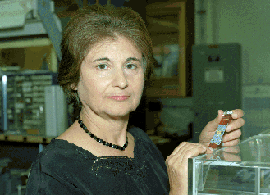

Physicist Lina Galtieri holds the LBL-designed electronic package that helped scientists detect and measure top quark candidates.
THE LONG HUNT FOR A CRUCIAL MISSING PIECE in the scientific picture of matter may be over. An international collaboration of physicists, including a team from the Lawrence Berkeley Laboratory, has announced the first experimental evidence for the subatomic particle known as the top quark.
The experiment was carried out at Fermi National Accelerator Laboratory's Tevatron, the world's most powerful collider, by the 440-member Collider Detector at Fermilab (CDF) collaboration. Though not claiming a confirmed discovery, the CDF group reports that analysis of high-energy collisions between beams of protons and antiprotons "points strongly" to the production of top quarks at a mass of about 174 GeV (billion electron volts), which is about as heavy as an atom of gold and makes the top quark by far the heaviest elementary particle ever observed.
The existence of the top quark is required by the Standard Model, the prevailing theory of the nature of matter. This theory holds there are six quarks, grouped into three distinct pairs, that combine to form composite particles, such as the protons and neutrons in the nuclei of atoms. The fifth of these six, called the bottom quark, was discovered at Fermilab in 1977. Scientists have been searching for its partner, the top quark, ever since.
"We were confident that we would eventually find the top quark," says Lina Galtieri, a physicist who heads the CDF group at LBL. "However, if we had gone much higher without finding it, then we might have to consider whether something was wrong with the Standard Model."
The key to revealing the top quark's existence was the CDF detector, which is actually a 2,000-ton array of more than 100,000 individual particle detectors arranged around a point in the Tevatron where beams of protons and antiprotons collide. This detector system serves as a giant trap from which no known particles (other than neutrinos) or forms of energy can escape.
"It is possible that we are seeing a rare statistical fluctuation," says Galtieri, "but we have a good indication that the top quark may be there."
Physicists and engineers at LBL designed a sophisticated microchip for the Silicon Vertex Detector (inset), an extremely high resolution instrument at the heart of the CDF array that enabled precise identification and tracking of bottom quarks. Galtieri's group also analyzed the CDF data to determine the mass of the top quark candidates. This analysis was based on a technique developed at LBL in the 1960s by the research group which was led by the late Nobel laureate Luis Alvarez.
"CDF's new evidence does not end the story but rather gives the first indications of a new field of research," says LBL physicist and CDF co-spokesperson William Carithers. "Many think that new phenomena are likely to show up at higher masses and the top quark is the most massive particle we know so far."
The CDF group expects that new data from another Tevatron experiment now underway will produce enough additional top quarks this year to confirm the particle's existence and to allow a more precise measurement of its mass. If the extremely large mass already reported is correct, it may help scientists better understand the process by which all objects acquire mass.
Return to LBL Research Review Table of Contents